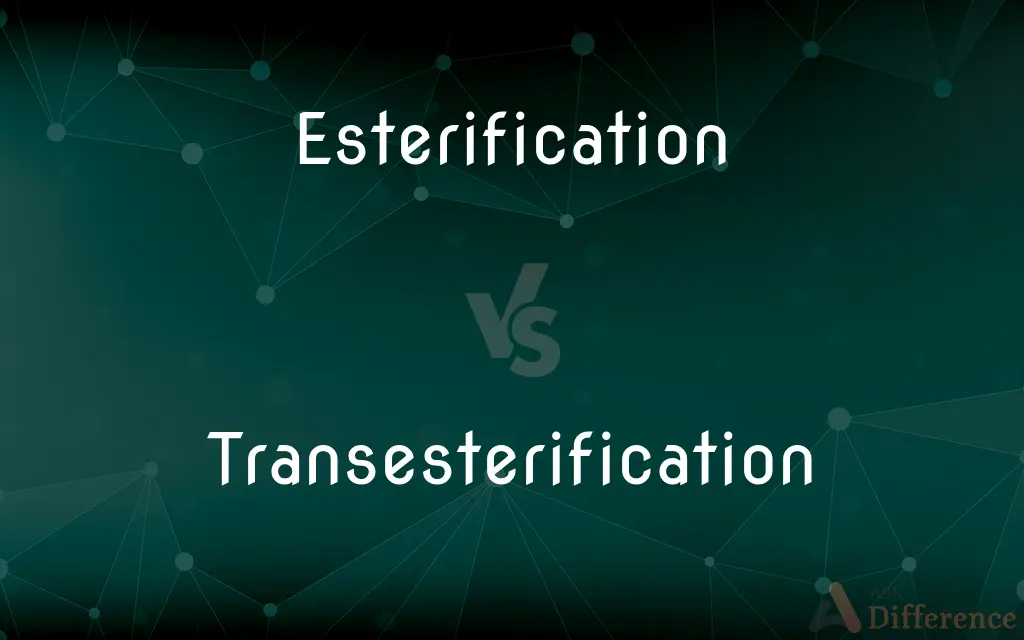Esterification vs. Transesterification — What's the Difference?
Edited by Tayyaba Rehman — By Fiza Rafique — Updated on September 27, 2023
Esterification is the reaction between an acid and alcohol to form an ester. Transesterification is the process of exchanging the organic group of an ester with the organic group of an alcohol.

Difference Between Esterification and Transesterification
Table of Contents
ADVERTISEMENT
Key Differences
Esterification and transesterification are both important chemical reactions involving esters. Esterification is the formation of an ester, usually achieved by reacting an acid (like carboxylic acid) with an alcohol. This reaction results in the formation of an ester and water as a byproduct. Transesterification, on the other hand, is a process where an ester reacts with an alcohol, leading to the formation of a different ester, essentially exchanging one ester for another.
While both esterification and transesterification involve esters, their processes and results differ. In esterification, an acid and alcohol combine, producing an ester and water. Transesterification, however, is a reshuffling of sorts. An existing ester undergoes this reaction in the presence of an alcohol, and the outcome is a different ester, along with the original alcohol component of the initial ester being displaced.
Applications of both esterification and transesterification are vast. Esterification is often utilized in the synthesis of esters for fragrances, flavors, and various industrial applications. Transesterification, meanwhile, is crucial in the production of biodiesel. Here, triglycerides, which are esters themselves, react with methanol in a transesterification reaction to produce biodiesel and glycerol.
Comparison Chart
Reaction Type
Formation
Exchange
Reactants
Acid and Alcohol
Ester and Alcohol
ADVERTISEMENT
Products
Ester and Water
Different Ester and displaced alcohol
Applications
Synthesis of fragrances, flavors, etc.
Production of biodiesel
Environmental Impact
Industrial significance
Direct role in renewable energy solutions
Compare with Definitions
Esterification
Organic reaction leading to the formation of ester, typically with water as a byproduct.
Esterification reactions are equilibrium reactions that can be driven to completion using Le Chatelier's principle.
Transesterification
A reshuffling reaction commonly applied in biodiesel production.
Transesterification reduces the viscosity of triglycerides, making the resultant biodiesel suitable for engines.
Esterification
The chemical reaction between an acid and an alcohol to produce an ester.
Through esterification, carboxylic acids and alcohols can be transformed into pleasant-smelling esters used in perfumes.
Transesterification
The chemical process in which the organic group of an ester is replaced by another organic group.
Transesterification of vegetable oils with methanol produces biodiesel.
Esterification
A process primarily used for creating synthetic esters.
Esterification in the lab can be catalyzed by sulfuric acid.
Transesterification
A reaction used to exchange the alkyl group of an ester.
The transesterification of ethyl acetate with methanol yields methyl acetate.
Esterification
A foundational concept in organic chemistry involving acid-catalyzed reactions.
Esterification of acetic acid with methanol results in methyl acetate.
Transesterification
Organic reaction producing a different ester, generally catalyzed by a base or acid.
Glycerol is a byproduct when triglycerides undergo transesterification with methanol.
Esterification
A method to derive esters from simpler organic compounds.
The esterification of fatty acids is essential in the production of biodiesel.
Transesterification
The process that converts triglycerides into simpler esters and glycerol.
Transesterification plays a pivotal role in making renewable diesel from plant sources.
Esterification
A chemical reaction resulting in the formation of at least one ester product.
Transesterification
In organic chemistry, transesterification is the process of exchanging the organic group R″ of an ester with the organic group R′ of an alcohol. These reactions are often catalyzed by the addition of an acid or base catalyst.
Esterification
(organic chemistry) Any reaction (typically between an acid and an alcohol) that results in the production of an ester
[http://www.sigmaaldrich.com/etc/medialib/docs/Aldrich/Acta/al_acta_30_01.pdf Aldrichimica Acta Volume 30 No 4] (pdf) from [http://www.sigmaaldrich.com/chemistry/chemical-synthesis/learning-center/aldrichimica-acta.html Sigma-Aldrich]
Transesterification
(organic chemistry) The reaction of an ester with an alcohol in order to replace the alkoxy group; it is used in the synthesis of polyesters and in the production of biodiesel
Common Curiosities
What is esterification?
Esterification is a chemical reaction where an acid (usually an organic acid) reacts with an alcohol to produce an ester and water.
Is esterification a reversible reaction?
Yes, esterification is reversible. The reverse reaction is called hydrolysis.
What is the byproduct of esterification?
Water is the byproduct.
What's a common use of the esters produced?
Esters are often used as fragrances and flavors in many products.
What are the reactants in esterification?
The reactants are typically an alcohol and an acid.
Can inorganic acids be used in esterification?
While organic acids are more commonly used, inorganic acids like sulfuric acid can act as catalysts in esterification.
Is the reaction endothermic or exothermic?
Transesterification is typically slightly exothermic.
What catalysts are used in transesterification?
Both acid and base catalysts can be used, with sodium or potassium hydroxide being common base catalysts.
What is the significance of glycerol in biodiesel production?
Glycerol is a byproduct of transesterification in biodiesel production and can be further processed for other industrial applications.
How does transesterification differ from esterification?
In transesterification, the reactants are an ester and an alcohol, while in esterification, they are an acid and an alcohol.
Can transesterification be reversible?
Yes, like esterification, transesterification is also reversible.
Can both reactions be catalyzed?
Yes, both esterification and transesterification can be catalyzed using either acid or base catalysts, depending on the specific reaction conditions and substrates.
What is the Fischer esterification?
Fischer esterification is a specific type of acid-catalyzed esterification named after Emil Fischer.
What is transesterification?
Transesterification is a chemical process that exchanges the organic group of an ester with the organic group of an alcohol.
Why is transesterification important in biodiesel production?
Transesterification is used to convert triglycerides (fats/oils) into biodiesel (alkyl esters) and glycerol.
Share Your Discovery

Previous Comparison
Lancer vs. Knight
Next Comparison
Humble vs. NobleAuthor Spotlight
Written by
Fiza RafiqueFiza Rafique is a skilled content writer at AskDifference.com, where she meticulously refines and enhances written pieces. Drawing from her vast editorial expertise, Fiza ensures clarity, accuracy, and precision in every article. Passionate about language, she continually seeks to elevate the quality of content for readers worldwide.
Edited by
Tayyaba RehmanTayyaba Rehman is a distinguished writer, currently serving as a primary contributor to askdifference.com. As a researcher in semantics and etymology, Tayyaba's passion for the complexity of languages and their distinctions has found a perfect home on the platform. Tayyaba delves into the intricacies of language, distinguishing between commonly confused words and phrases, thereby providing clarity for readers worldwide.














































